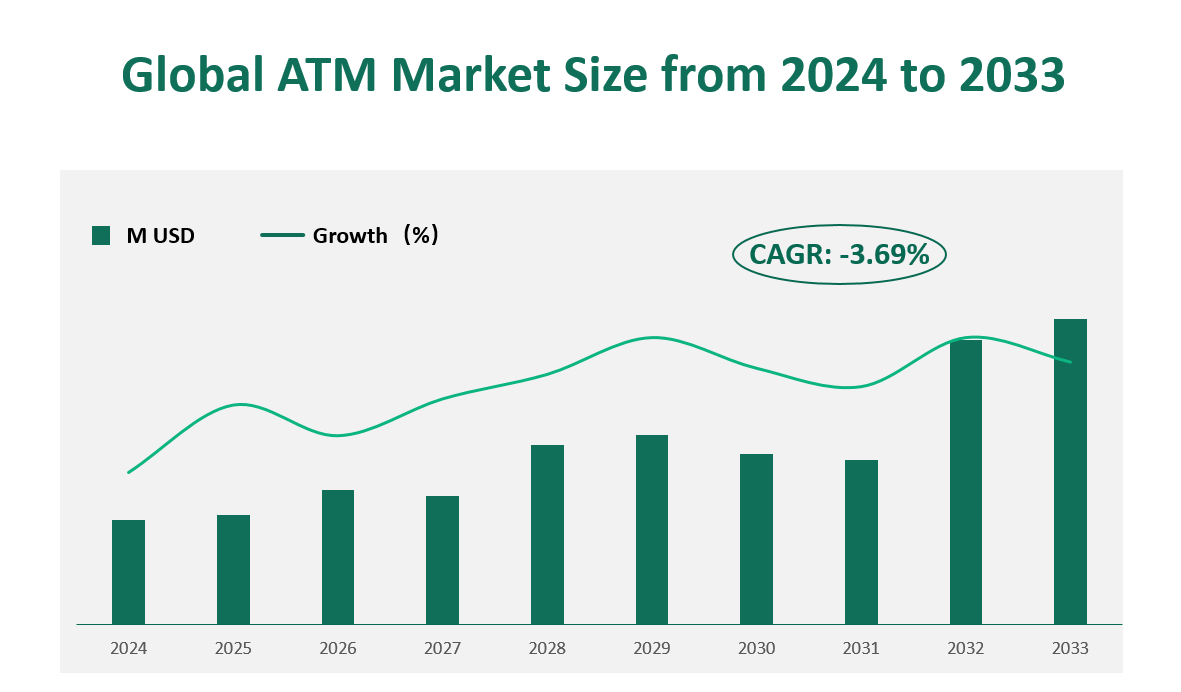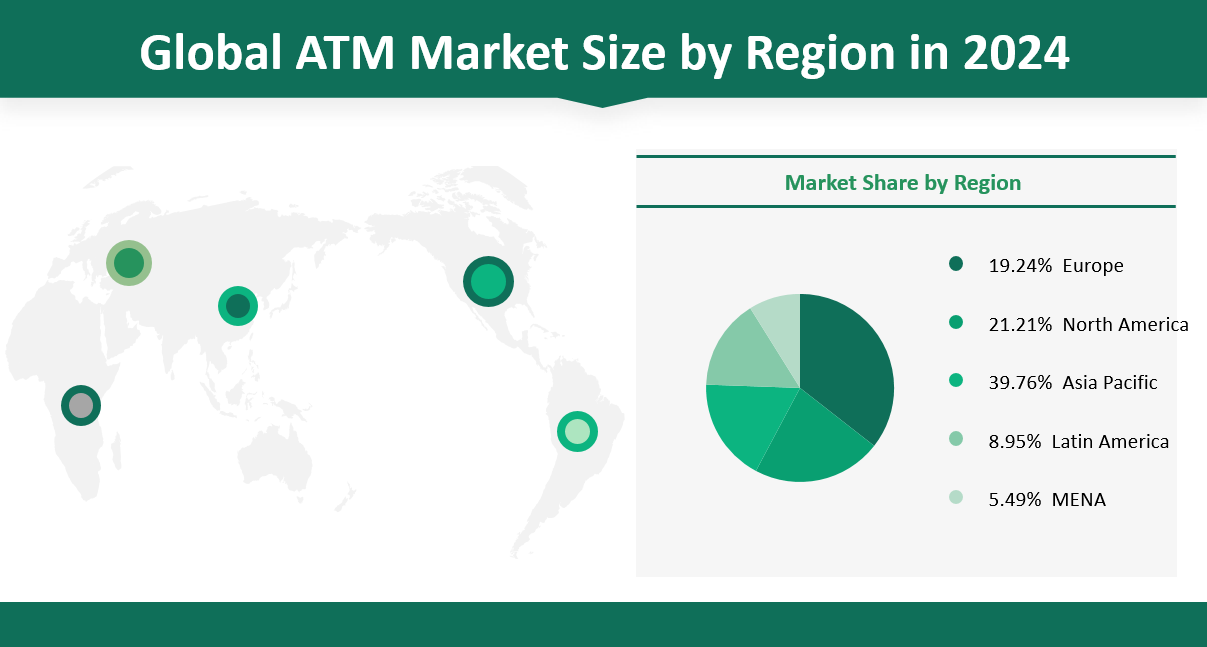1 Global ATM Market Size (Revenue) and CAGR (2024-2033)
The global ATM market is an essential component of financial infrastructure, providing essential services for cash transactions and banking. The market is expected to reach a value of $2921.84 million by 2024. The compound annual growth rate (CAGR) from 2024 to 2033 is -3.69%, indicating a decline in the market value during this period. CAGR is a statistical measure that represents the average annual growth rate of an investment over a specific period of more than one year. It is used to calculate the average rate of return required for an investment to grow from its initial value to its final value, assuming that profits are reinvested at the end of each year of the time period.
An ATM, or automated teller machine, is a complex electromechanical device that enables self-service financial transactions using magnetic or smart cards. These machines can perform a variety of functions, including cash withdrawals, balance inquiries, fund transfers, and even cash deposits. The decline in the global ATM market value can be attributed to several factors, including the growing popularity of digital banking solutions, reduced reliance on physical cash, and the rise of mobile payments and online banking services. These trends are expected to continue as the market adapts to new consumer behaviors and technological innovations, further influencing the CAGR in the coming years.
Figure Global ATM Market Size (M USD) Outlook (2024-2033)

2 ATM Industry Drivers and Restraints
2.1 Drivers of ATM Market Growth
Technological Advancements: The integration of advanced technologies such as biometrics, cash recycling, and contactless payments has enhanced the functionality of ATMs, making them more secure and user-friendly. These innovations not only improve the customer experience but also provide banks with the tools to offer additional services, thereby driving the demand for advanced ATMs.
Financial Inclusion: The drive for financial inclusion, especially in emerging economies, has led to an increase in the number of people using banking services. ATMs play a vital role in providing financial services in areas where bank branches are sparse, thereby increasing the market potential for ATM deployment.
The Rise of Digital Payments: While one might think that the rise of digital payments would reduce the use of ATMs, it has actually led to an evolution in ATM services. Banks are upgrading ATMs to support mobile payment integration and other digital banking services, ensuring that ATMs remain relevant in the digital age.
Global Economic Growth: Economic growth in regions such as Asia Pacific and the Middle East has led to increased consumer spending and a greater demand for convenient banking services provided by ATMs. This growth has led to an increase in the demand for ATMs in these regions.
2.2 Restraints to ATM Market Growth
Shift to Cashless Transactions: The growing preference for cashless transactions and digital wallets poses a major challenge to the ATM industry. As more consumers and businesses adopt digital payment methods, the demand for cash withdrawals, the primary function of ATMs, is declining.
Cybersecurity Concerns: ATMs are vulnerable to cyberattacks, which can lead to data breaches and financial losses. The need for strong security measures increases operating costs and may prevent banks from deploying more ATMs, especially in areas with higher cybersecurity risks.
High Maintenance and Operating Costs: ATMs require regular maintenance, software updates, and cash management, which can be costly. Smaller banks and financial institutions may find it difficult to maintain an extensive ATM network, leading to a slowdown in ATM deployment.
Regulatory Compliance: Stringent regulations and compliance requirements in various countries may hinder the growth of the ATM market. Banks must deal with a complex legal environment, which may delay the deployment of new ATMs and increase operating costs. In summary, the ATM market is affected by a complex interaction of drivers and restraints. While technological advancements and the drive for financial inclusion have fueled market growth, the shift toward cashless transactions and cybersecurity concerns present significant challenges. Understanding these dynamics is critical for stakeholders to navigate the changing ATM landscape and capitalize on emerging opportunities.
In summary, the ATM market is affected by a complex interaction of drivers and restraints. While technological advancements and the drive for financial inclusion have fueled market growth, the shift toward cashless transactions and cybersecurity concerns present significant challenges. Understanding these dynamics is critical for stakeholders to navigate the changing ATM landscape and capitalize on emerging opportunities.
3 Global ATM Revenue Share by Type in 2024
The global ATM market is segmented into various product types, each with its own definition and market size. The market is expected to be dominated by on-site ATMs located within bank premises in 2024. These ATMs are designed to provide customers with safe and convenient banking services, allowing them to conduct transactions without the need for a human teller. On-site ATMs are vital to banks as they provide a high level of security and integrate with the bank’s internal systems for efficient transaction processing.
On the other hand, off-site ATMs are located in various locations independent of financial institutions. These machines are designed to provide convenience to customers in areas where there are no bank branches nearby. Off-site ATMs are essential for providing banking services in remote areas, and retailers and other businesses often use them to provide cash withdrawal services to customers.
In terms of market size, on-site ATMs are expected to reach a market value of $2,445.15 million in 2024, while off-site ATMs are expected to reach a market value of $476.69 million. The market size of both types combined is expected to be $2,921.84 million. On-site ATMs account for the largest market share at 83.69%, while off-site ATMs account for 16.31% of the total market. Overall market trends indicate that both on-site and off-site ATMs will continue to evolve with technological advancements and changes in consumer behavior. The integration of new technologies such as biometrics, multi-currency exchange, and virtual currency transactions is expected to drive growth in both segments, enhancing the functionality and appeal of ATMs in meeting different customer needs.
Figure Global ATM Revenue Market Share by Type in 2024
Type | Market Size (M USD) 2024 | Market Share 2024 |
On-site ATM | 2445.15 | 83.69% |
Off-site ATM | 476.69 | 16.31% |
Total | 2921.84 | 100.00% |
4 Global ATM Revenue Share by Application in 2024
The ATM market has diverse applications, each serving a different area of the banking and financial industry. The main applications include banking and retail, each with different functions and market sizes. Bank ATMs are designed to provide a wide range of financial services, including cash withdrawals, balance inquiries, and fund transfers. These machines are usually located within bank premises and are open 24/7, providing customers with the convenience of conducting banking transactions without the need for human tellers.
On the other hand, retail ATMs are strategically placed in retail environments such as shopping malls, supermarkets, and convenience stores. These machines meet shoppers’ immediate cash needs and provide a quick and convenient way to access funds while shopping.
In 2024, banking applications are expected to account for the largest market share with a forecast value of US$2,292.51 million, accounting for 78.46% of the total ATM market. The market size of retail applications is expected to be US$629.33 million, accounting for 21.54% of the total market. The dominance of banking applications is attributed to their important role in providing core banking services, while the growth of retail applications is driven by the growing demand for convenient cash access in retail environments.
Table Global ATM Revenue Market Share by Application in 2024
Application | Market Size (M USD) 2024 | Market Share 2024 |
Banking | 2292.51 | 78.46% |
Retail | 629.33 | 21.54% |
Total | 2921.84 | 100.00% |
5 Global ATM Market Revenue Share by Region in 2024
The global ATM market is segmented by major regions, each with its own market size and growth drivers. In 2024, Asia Pacific is expected to lead with the largest market share, reflecting its important role in the global ATM market. North America and Europe also contribute significantly to the market size, offering diversified banking solutions tailored to regional needs.
Market data suggests that Asia Pacific will continue to be an important part of the global ATM market, with a projected value of $1,161.75 million in 2024, accounting for 39.76% of the total market. North America’s market size is expected to be $619.66 million, accounting for 21.21% of the total market, while Europe’s market share is expected to be 19.24%, with a value of $562.10 million. Latin America, the Middle East and North Africa region, and other regions also contribute to the global ATM market, with varying market shares and growth potential. Overall market trends suggest that emerging economies and regions with increasing financial inclusion are likely to experience faster growth in ATM adoption. The adaptability of ATM services to different regional markets and consumer preferences is likely to influence the growth rates in different regions in the coming years.
Figure Global ATM Market Revenue Share by Region in 2024

6 Global ATM Revenue Market Share by Major Players in 2024
The ATM market is dominated by several key players, each with its own products and market position. The top five companies in the market include Diebold Nixdorf, NCR Atleos, Hitachi Channel Solutions, Corp., GRG Banking, and Oki Electric Industry Co., Ltd.
Diebold Nixdorf: Founded in 1859, Diebold Nixdorf is a leading provider of software and hardware services to the financial and retail industries. The company offers a range of ATM products, including the DN Series® Lobby ATM self-service solution. Diebold Nixdorf is expected to generate revenue of $841.31 million in 2024.
NCR Atleos: Founded in 1884, NCR Atleos specializes in digital banking, POS systems, and payment solutions. The company’s ATM products include the NCR SelfServ™ 21, which is designed for efficient cash dispensing and enhanced security. In 2024, NCR Atleos is expected to achieve revenue of USD 774.44 million.
Hitachi Channel Solutions: Established in 2004, Hitachi Channel Solutions provides planning, development, design, manufacturing, sales and service of ATMs and other information equipment. The company’s ATM products focus on cash recycling and advanced security features. In 2024, Hitachi Channel Solutions is expected to achieve revenue of USD 296.64 million.
GRG Banking: Established in 1999, GRG Banking Equipment Co Ltd is engaged in the development and manufacturing of automated teller machines. The company’s products and services include retail solutions and financial self-service solutions. In 2024, GRG Banking is expected to achieve revenue of USD 182.98 million.
OKI: Established in 1949, OKI develops, manufactures and sells a variety of communication and information-related equipment, including ATMs. The company’s ATM products focus on high-speed transactions and large-capacity banknotes. In 2024, OKI Electric Industry Co., Ltd. is expected to achieve revenue of $217.23 million.
These companies are at the forefront of the ATM market, providing innovative solutions and maintaining a strong market position. Their products and sales revenues reflect their commitment to meeting the diverse needs of the banking and financial industry.
Table Global ATM Revenue Market Share by Major Players in 2024
2024 | |
28.79% | |
26.51% | |
10.15% |





